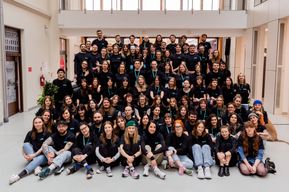
What Anima International did in 2025
December 31, 2025
October 24, 2022
On 24 February 2022, Russia invaded Ukraine in a major escalation of the war that began in 2014. The invasion created Europe’s largest refugee crisis since World War II, with around 7 million Ukrainians fleeing the country and a third of the population displaced. It has also caused global food shortages.
The war has significantly impacted Anima International’s operations in Eastern Europe. After stopping work in Russia, the organization attempted to compile information on the situation of Ukrainian animal farms during the war and understand how to effectively help them in the face of war. Over the course of nearly two months, Anima International’s activists contacted more than 300 farms from across the country. Results of the analysis were published in the report on Ukrainian livestock farms during the war.

Anima International started to work in Ukraine in 2017. For over five years, the organization has been effectively working to improve the lives of farmed animals in the country. The two main areas of the organization’s focus were enhancing the welfare of laying hens and partnering with food producers to introduce and promote alternative animal products on the Ukrainian market.
Russian invasion of Ukraine has rendered the organization’s previous activities largely impossible. However, determined to continue to work effectively to end the suffering of farmed animals, our Ukrainian team decided to first understand what effect the war has had on the livestock industry.
Ukraine is a large producer of meat and dairy products. According to 2018 data, Ukraine was among the world’s top ten egg producers with an annual production of 937,300.00 tonnes. The annual number of animals slaughtered for meat is estimated at 2.15 million cattle, 2.61 million turkeys, and 8.14 million pigs. However, the largest sub-sector of livestock production in Ukraine is the poultry industry. The biggest Ukrainian broiler producer, MHP, holds 17th place on the list of the World’s TOP 50 broiler producers. The number of chickens slaughtered for meat in 2018 was 658.15 million. In 2021, the production of broiler chickens in Ukraine was 1.6 million tonnes (live weight) of which 400,000 tonnes were exported.
Anima International reviewed the status and condition of Ukrainian farms three months into the Russian invasion of Ukraine. The applied methodology contains:
Listed below is some of the information collected by Anima International. The English translation of the full document, originally published in Ukrainian, is available here.

From April 6 to May 31, 2022, Anima International’s activists randomly selected 303 farms across Ukraine and conducted a survey asking the farm owners if their facilities have suffered as a result of the Russian invasion. Out of the 303 farms, activists managed to obtain information about 139 establishments (46.2%). The absence of a response in the case of more than half of the farms that the activists tried to contact was mainly due to the lack of telephone connection, as well as the high caution of farm owners, who were reluctant to provide information on potential damage over the phone.
Damages caused by the war have been reported on 39 farms, which constitute 27.8% of the responses received and 12.9% of all farms that were contacted. The responses obtained during the survey were divided geographically and set in the context of the intensity of hostilities in a given region.
In the northern part of the country, which was heavily affected by the warfare in the first months of the invasion, activists were informed about a number of farms affected by the war, including:
It seems particularly difficult to collect information on the situation of the farms in eastern and southern Ukraine, where either fighting was taking place, or the territory was at that point occupied by the Russian army. However, also in these areas of the country, activists report on several cases, including the case from Chornobayivka, Kherson region, where four million animals have been killed at Europe’s largest broiler chicken farm. The deaths of the birds were caused by starvation after a power outage shut down the automatic feeding system.
While the results of the research conducted by Anima International reveal numerous examples of damage on farms, the full picture of animal husbandry in Ukraine during the war remains unknown. Due to logistical constraints, the ability to conduct reliable research in the country as well as collect data from certain regions is highly limited. As fighting in the region continues with frequent air strikes on Ukrainian infrastructure, more damage and animal deaths are expected.
Marta Cendrowicz is the Director of Global Growth for Anima International. For more than 5 years Marta was the Director of Corporate Relations at the Polish branch of Anima International. Currently her primary area of responsibility is the internal growth of the organization with the main focus on Eastern European countries.
